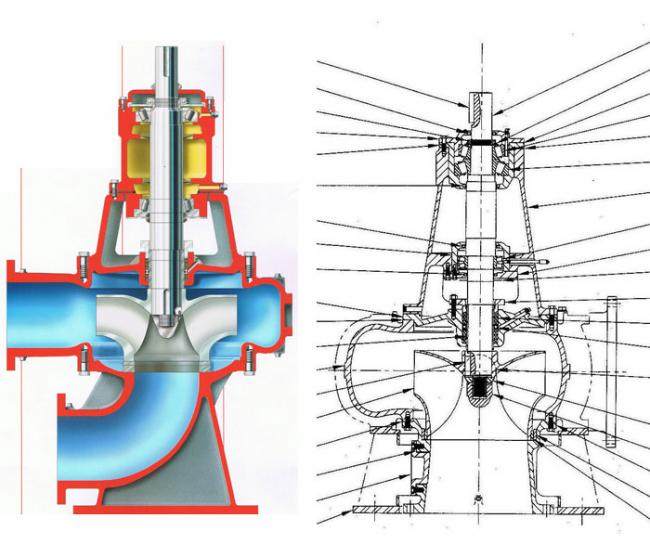Pumps & Systems, February 2009
In December 2008, we discussed some reasons ball bearings run hot. In December 2006 (ref. [1]), we described the common pitfalls of incorrectly dimensioning shafts during repairs. This time, we will examine the cousin of a ball bearing-a roller bearing-and some of the pitfalls that occasionally cause hot operation.
In general, there are two main types of anti-friction bearings: ball and roller. Each type has many sub-variations, but the main distinction is a point contact for the ball bearings, versus a line contact for the rollers. Roller bearings are used for significantly higher loads, with the line contact providing better load carrying capability compared to the point contact of ball bearings. With greater (line versus point) contact with the surface, however, rollers do generate more heat, and typically operate at somewhat higher temperature as compared to ball bearings.
The shape of the line of contact, geometry of the roller ends, manufacturing and QA methods, and other factors play significant roles in minimizing heat generation. The ability of single row tapered roller bearings to accommodate angular misalignments is limited to just a few minutes (1/60th of a degree), so they are only able to compensate for alignment errors of this magnitude. Some bearing manufacturers use a logarithmic profile, which helps increase the maximum allowable value of misalignment to three minutes (3/60th of a degree) of an arc. That is better, but not by much. Remember that we are not talking about the misalignment between the shafts of the pump and the motor (another important, but different, subject), but the concentricity of the bearing housing bores to each other.
Consider, as an example, a design comparison of two medium size end suction vertically oriented centrifugal pumps (see Figure 1) with a 24-in distance between the bearing centers and shaft size of 4-in.

Figure 1. Spherical self-aligning roller bearing is added at one of the positions along the shaft, making it less sensitive (due to "swing" of the shaft) to errors in concentricity of the bores (misalignment of the bores)
Just to get a feel for the numbers, suppose the housing ID to receive the bearings is on the order of 8-in. The accuracy of maintaining the precise dimension (tolerance on the diameter) was discussed in December 2006. It is important, as is the accuracy of the dimension of each individual bearing housing bore and the concentricity of the bores. To stay within the allowable misalignment of the bearing of one minute (1/60 of a degree), we need to solve a simple geometric relationship:
Tangent (1 minute) = c/L
Where:
c = Concentricity
L = Distance between the bearing centers
From that:
C = 12 inches x tan(1/60 degree) = 0.003 inches
If the bores in this example are concentric within 3-mils (not much!), the bearings would be operating within an allowable misalignment. More than that, and misalignment would be excessive-resulting in hot bearings and likely failures.
New pumps are typically not expected to have such problems, but the bore concentricity needs to be checked during repairs after several years of operation. Failure to do so, along with other related issues, often leads to problems (ref. [2]).
To reduce the sensitivity of the design to bearing misalignment, a spherical roller bearing can be installed at one of the positions, instead of the two tapered cylindrical roller bearings. Analogous to a pillow block, a spherical bearing is less sensitive to misalignment, and less prone to related issues . As shown on Figure 1, the upper (cylindrical roller) bearings are arranged facing each other, and a lower set of bearings has a spherical design (self aligning capability), a significantly better tolerance to misalignment and mis-machining.
In this series of articles, we have covered the effects on bearings operation of dimensional accuracy, concentricity, lubrication (ref. [3]) and loads.
A parting quiz: How badly off would the concentricity of the housing bores need to be to cause misalignment issues for the case discussed above, when a spherical roller bearing is used as shown on Figure 1 (right)? The first three correct respondents win a free ticket to the next Pump School session.
References:
[1] Nelik, L., "Bearings: Theory, Reality, and Russian Sputniks," Pumps & Systems, December 2006, page 26
[2] Cronin, R.J., House, D.A., and Miller, A.C., "Design Considerations for Nonlcog Pumps," Proceedings of International Pump Symposium, March 2004, Houston, TX
[3] Nelik, L., "Bearings Life Extension and Reliability features of Modern ANSI Pumps," Proceedings of the 2nd International Conference on Equipment Reliability," Houston, TX, November 15-18, 1993
Read Lev Nelik's December 2006 and December 2008 article in the Article Archives.


